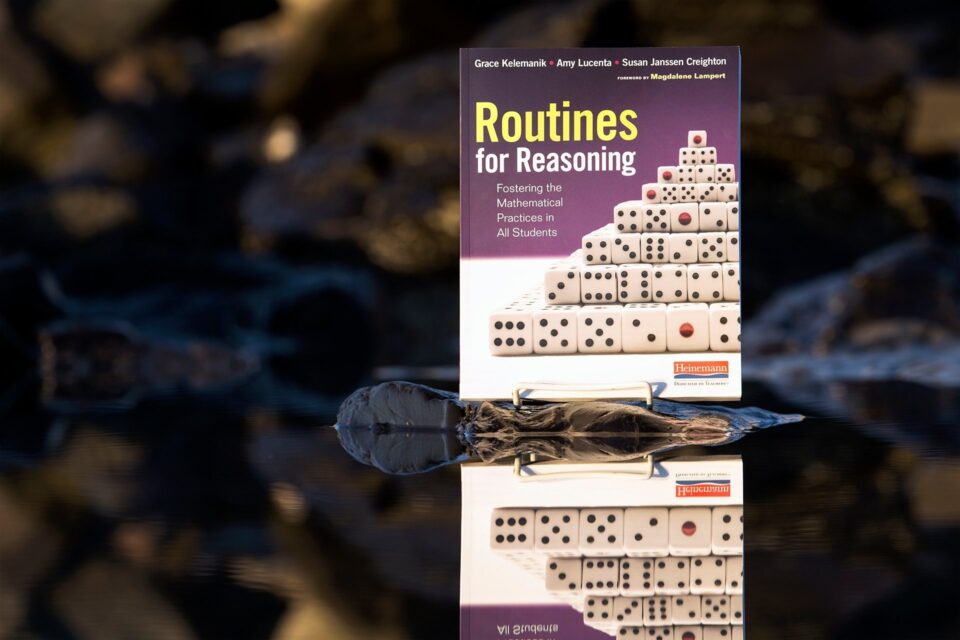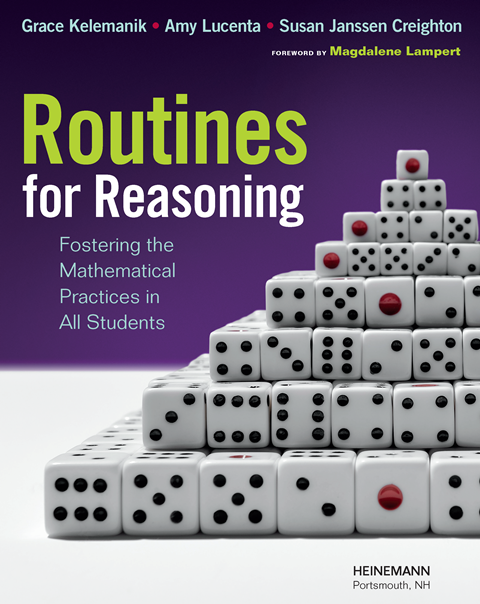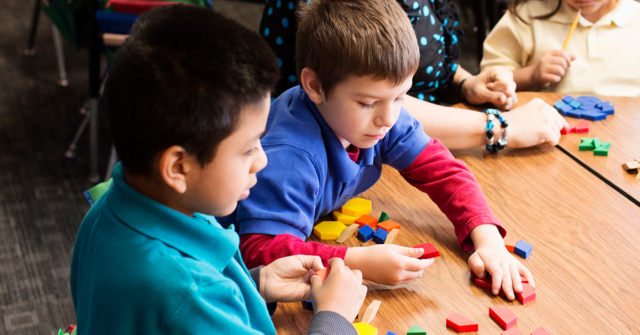
By Grace Kelemanik, Amy Lucenta, and Susan Janssen Creighton, adapted from their new book, Routines for Reasoning
Imagine a routine focused not on classroom management procedures but on ways of thinking mathematically when faced with an unfamiliar problem. Like the management routines, these “mathematical thinking routines” also have a predictable set of actions that students learn and then practice repeatedly until they are second nature.
They may involve getting started with an unfamiliar mathematics problem, or looking for relationships between two seemingly unrelated mathematical representations, or seeking regularity in a collection of computations to create a generalized equation.
The primary difference between these instructional routines and classroom management routines is that while general classroom management routines are often designed to efficiently transition from one learning opportunity to the next, instructional routines are situated in the learning opportunity itself, providing students with a predictable frame for engaging with the content. As the organization of a particular part of a lesson becomes increasingly familiar over time, both the teacher and the students know what to expect and can move fluidly in and through that part of the lesson.
Effective instructional routines provide access to mathematics in three key ways:
- They allow for a greater focus on learning.
- They help students and teachers build crucial mathematical thinking habits.
- They provide a wider range of learners with access to the development and use of the math practices.
When people are first learning to drive, they are faced with a million small details to attend to: when and how to adjust mirrors, how to operate headlights, how to operate wipers, how to operate the radio or music, finding money for tolls at an upcoming toll booth—and all this on top of the crucial skills of steering, accelerating, braking, and paying attention to the movements of other drivers around them. As drivers become more familiar with their vehicle and the act of driving, many of these small, repeated actions become automatic and require little attention or thought, allowing drivers to focus most of their attention (we hope!) on their own movement and the movement of other drivers around them. Instructional routines serve the same function: they make more predictable the design and flow of the learning experience: “What is it that I’m supposed to be doing?” “What question will I be asked next?” or “How will things work today in the lesson?” The predictable structure lets students pay less attention to those questions and more attention to the way in which they and their classmates are thinking about a particular math task.
Research tells us about best practices for struggling learners; here are three ways effective instructional routines provide access to math for a wide range of learners:
- Routine use
Instructional routines are intended to be used, well, routinely! The growing predictability and familiarity of each routine help students build a growing repertoire of tools for tackling unfamiliar problems and build their confidence in being able to do the mathematics. This is especially valuable for those students who lack confidence that they can be successful at all in math class.
- Focus on thinking
Routines must be structured to keep the instructional focus on developing the thinking—which is where the math practices emerge—rather than on focusing predominantly on getting an answer. When the focus remains on the thinking, there is more room for different students’ ways of thinking to become part of the discussion. Routines help students work through their thinking, while still leaving room for students’ individual thought processes to emerge.
- Promote participation
Routines should provide a structure for both teacher and students that creates a language-rich environment, involves use of multiple modalities and representations, and structures ways for students to successfully participate in discussions around those representations and the thinking that underlies them. And finally, the built-in, ample processing time makes room for learners who need different amounts of time to make sense of the mathematics, whether because of a language issue or a disability or just because they do, while still engaging those who have already “arrived” at a productive way to solve the problem.
For you as the teacher, routines keep the flow of the mathematics instruction deliberately predictable so that, as you gain familiarity with them, you can better attend to the most unpredictable elements of your mathematics instruction: how your students are making sense of the mathematics.
 Grace Kelemanik has more than 30 years of mathematics education experience. A frequent presenter at national conferences, her work focuses on urban education, special populations, and teacher training. Amy Lucenta has extensive K–12 mathematics experience with all students, including a focus on special populations. She is a frequent professional development provider who helps teachers implement the Standards for Mathematical Practice. Susan Janssen Creighton is a senior mathematics associate at Education Development Center (EDC) in Massachusetts. She has a particular focus on developing mathematics curriculum and teacher professional development.
Grace Kelemanik has more than 30 years of mathematics education experience. A frequent presenter at national conferences, her work focuses on urban education, special populations, and teacher training. Amy Lucenta has extensive K–12 mathematics experience with all students, including a focus on special populations. She is a frequent professional development provider who helps teachers implement the Standards for Mathematical Practice. Susan Janssen Creighton is a senior mathematics associate at Education Development Center (EDC) in Massachusetts. She has a particular focus on developing mathematics curriculum and teacher professional development.


